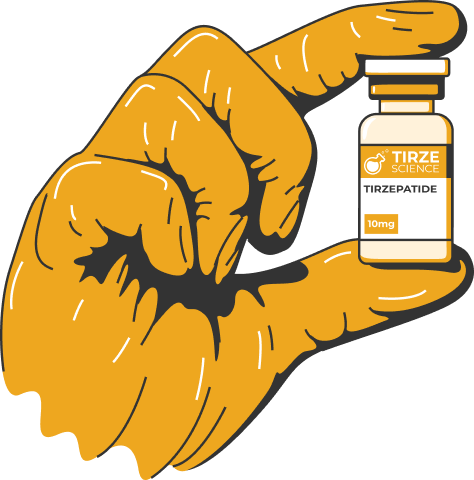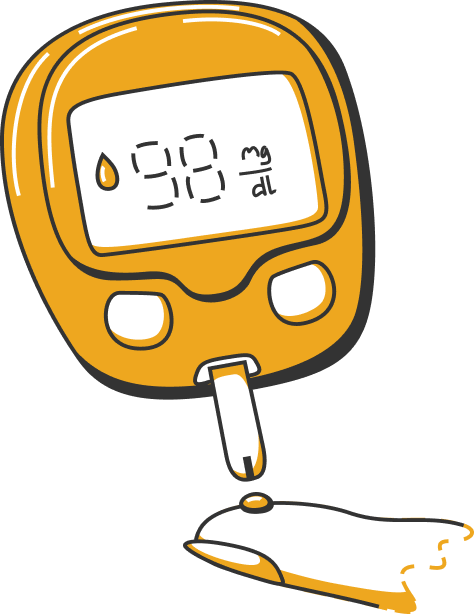What is Tirzepatide and What does it Do?

What is Tirzepatide?

What is Tirzepatide?
Chemical Structure

Tirzepatide Mechanism of Action - How does it Work?

Tirzepatide Mechanism of Action - How does it Work?
Tirzepatide works in a unique and effective way to help manage type 2 diabetes and support weight loss. Here are the steps that explain how this peptide affects human body:
Dual Hormone Mimicking: Tirzepatide is special because it imitates the actions of two important hormones in our body - GLP-1 (Glucagon-like peptide-1) and GIP (Glucose-dependent insulinotropic polypeptide). These hormones play crucial roles in controlling blood sugar and appetite.
Boosting Insulin Production: When blood sugar levels rise after eating, GLP-1 and GIP usually tell the pancreas to produce more insulin. Insulin is a hormone that helps lower blood sugar by allowing it to enter the body's cells. Tirzepatide enhances this natural process, ensuring more insulin is released when needed.
Slowing Down Digestion: By mimicking GLP-1, Tirzepatide also helps slow down the rate at which food leaves the stomach. This means you feel full for longer, which can help reduce how much you eat and support weight loss efforts.
Reducing Sugar Production: Besides helping with insulin secretion, Tirzepatide reduces the amount of sugar the liver releases into the bloodstream. This is important because, in type 2 diabetes, the liver can produce too much sugar, contributing to high blood sugar levels.
Suppressing Appetite: Both GLP-1 and GIP have roles in regulating appetite. Tirzepatide, by acting like these hormones, can help reduce hunger signals, leading to lower calorie intake and weight loss over time.
Using Tirzepatide correctly is crucial for achieving the best outcomes in managing type 2 diabetes and supporting weight loss.
Starting Dose: Tirzepatide treatment typically begins with a low dose to help your body adjust to the medication. The starting dose is usually 2.5 mg, taken once a week.
Gradual Increase: After starting, the dose can be gradually increased based on your doctor's recommendation and how well you tolerate the medication. This step-by-step increase helps minimize side effects.
Maintenance Dose: The effective maintenance dose can vary, but it generally falls within the range of 5 mg to 15 mg once a week. Your healthcare provider will determine the optimal dose for you, considering your health condition, response to the medication, and treatment goals.
How to Administer: Tirzepatide is administered as an injection under the skin (subcutaneously). Common sites for the injection include the abdomen, thigh, or upper arm. Rotating the injection site each week is important to avoid skin issues.
Best Time to Take: You can take Tirzepatide at any time of the day, with or without food. However, it's beneficial to inject it at the same time each week to maintain a consistent routine.
Storage and Handling: Store Tirzepatide in the refrigerator before use. If needed, it may be kept at room temperature for a limited period, as specified by the manufacturer. Always check the medication's appearance before use; it should be clear and colorless.
Monitoring and Adjustments: Regular check-ups with your healthcare provider are essential. They will monitor your progress, including blood sugar levels and weight changes, and adjust the dosage if necessary.
Are There Side Effects?
Are There Side Effects?
When taking Tirzepatide, like with many medications, some people may experience side effects. Knowing what these are can help you be prepared and manage them effectively.
- Gastrointestinal Issues: The most common side effects are related to the digestive system. You might feel nauseous, have diarrhea, experience vomiting, or deal with constipation. Some people also report having stomach pain.
- Appetite Changes: Tirzepatide affects hormones regulating hunger, so you might notice a decreased appetite.
- Fatigue: Feeling unusually tired or weak is another side effect some people encounter.
- Injection Site Reactions: The area of skin where you inject Tirzepatide might become red, itchy, or swollen. This is usually mild and goes away after a while.

Is it FDA Approved?

Is it FDA Approved?
Yes, Tirzepatide is FDA-approved. The U.S. Food and Drug Administration (FDA) has given its approval for Tirzepatide to be used as a treatment option for adults with type 2 diabetes. This approval is based on comprehensive research and clinical trials that demonstrated Tirzepatide's effectiveness in helping manage blood sugar levels and, in certain dosages, supporting weight loss.
The FDA's endorsement confirms that Tirzepatide meets the necessary safety and efficacy standards for medical care for the specified conditions. Patients need to discuss with their healthcare provider whether Tirzepatide is a suitable option for their treatment plan, considering their overall health and treatment goals.
Does Tirzepatide Expire?
Does Tirzepatide Expire?
Like all medications, Tirzepatide does expire. Medication expiration dates are important because they indicate the last day the manufacturer guarantees the full potency and safety of a drug. After this date, the effectiveness of Tirzepatide may decrease, and it might not work as expected in managing blood sugar levels or aiding in weight loss.
It's key to check the expiration date on the Tirzepatide packaging before use. If it's past this date, you should not use the medication. Instead, dispose of it properly and obtain a new supply. Your healthcare provider or pharmacist can guide you on the correct disposal methods and how to get a replacement.
